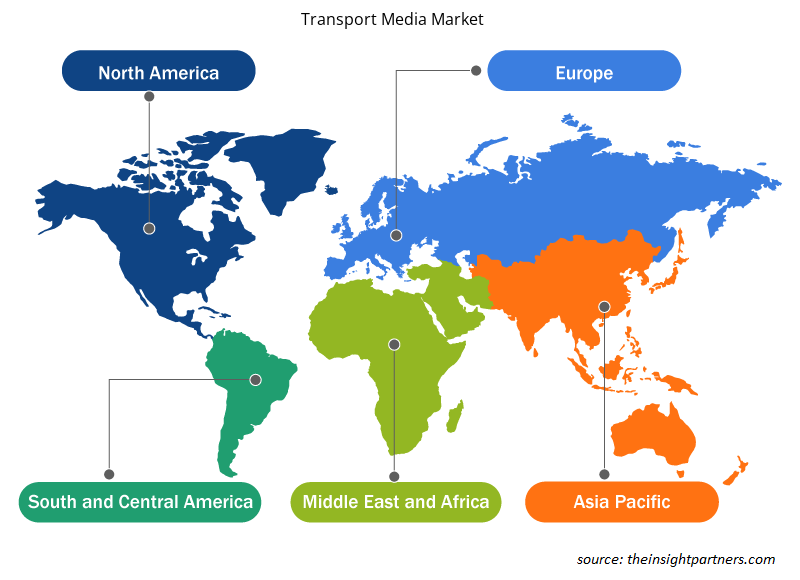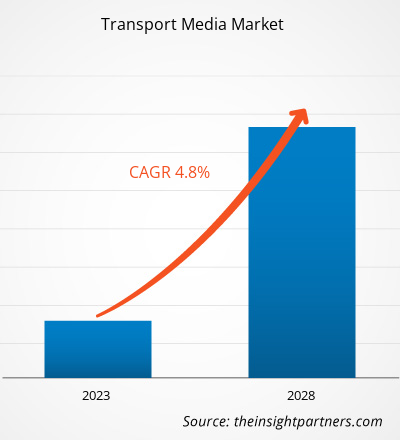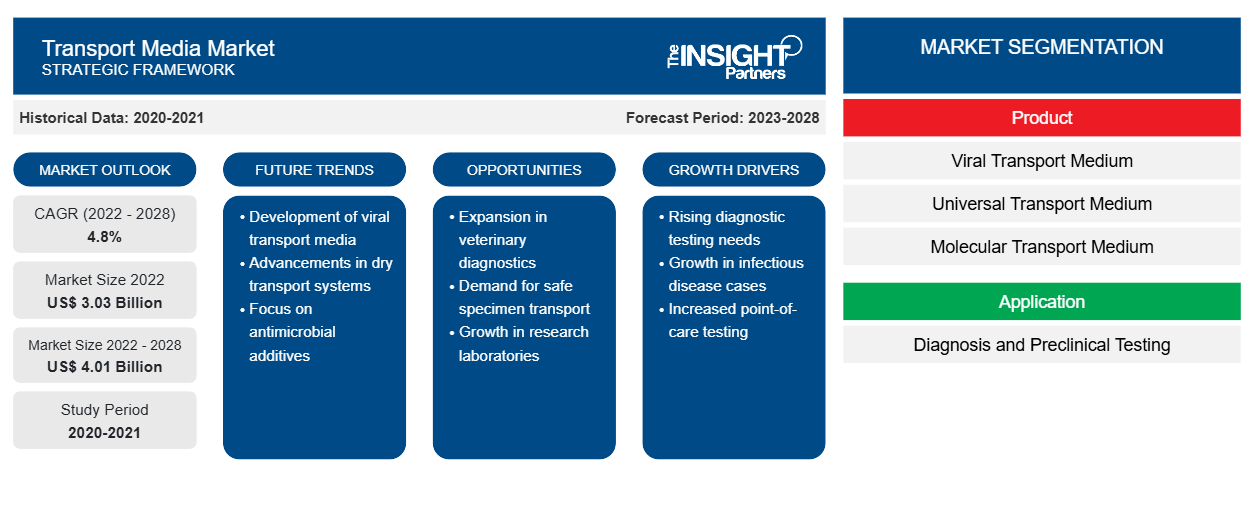Der Transportmedienmarkt soll von 3.030,21 Millionen US-Dollar im Jahr 2022 auf 4.014,88 Millionen US-Dollar im Jahr 2028 wachsen; von 2021 bis 2028 wird eine durchschnittliche jährliche Wachstumsrate (CAGR) von 4,8 % erwartet.
Das mikrobielle Transportmedium ist im Wesentlichen ein Puffer, der Nährstoffe (außer Wachstumsfaktoren) wie Kohlenhydrate und Peptone enthält und so konzipiert ist, dass die Bakterienlebensfähigkeit während des Transports erhalten bleibt, ohne dass Bakterienwachstum stattfindet. Der Hauptzweck der Verwendung eines Transportmediums besteht darin, die Probe so nah wie möglich an ihrem ursprünglichen Zustand zu liefern.
Das Wachstum des Transportmedienmarktes ist auf die steigende Nachfrage zurückzuführen, die auf die zunehmende Zahl von Initiativen der Regierung zur Erhöhung der Akzeptanz von Testkits zurückzuführen ist. Klinische und technische Probleme im Zusammenhang mit der Abstrichentnahme und den Transportmedien schränken das Marktwachstum jedoch ein.
Der Transportmedienmarkt ist nach Produkt, Anwendung, Endbenutzer und Geografie segmentiert. Geografisch ist der Markt grob in Nordamerika, Europa, Asien-Pazifik, den Nahen Osten und Afrika sowie Süd- und Mittelamerika unterteilt. Der Marktbericht bietet Einblicke und eingehende Analysen des Marktes und betont Parameter wie Marktgröße, Trends, technologische Fortschritte und Marktdynamik sowie die Analyse der Wettbewerbslandschaft der weltweit führenden Marktteilnehmer. Darüber hinaus enthält der Bericht die Auswirkungen der COVID-19-Pandemie auf den Transportmedienmarkt in allen Regionen.
Passen Sie diesen Bericht Ihren Anforderungen an
Sie erhalten kostenlose Anpassungen an jedem Bericht, einschließlich Teilen dieses Berichts oder einer Analyse auf Länderebene, eines Excel-Datenpakets sowie tolle Angebote und Rabatte für Start-ups und Universitäten.
-
Holen Sie sich die wichtigsten Markttrends aus diesem Bericht.Dieses KOSTENLOSE Beispiel umfasst eine Datenanalyse von Markttrends bis hin zu Schätzungen und Prognosen.
Markteinblicke
Nachfrageanstieg aufgrund der COVID-19-Pandemie treibt Wachstum im Transportmedienmarkt voran
Die Nachfrage nach Transportmedien stieg mit der Zunahme der COVID-19-Tests. Damit Tests genau und zuverlässig sind, sind die Qualität der Probe sowie die Transport- und Lagerungsbedingungen der Probe vor der Verarbeitung von entscheidender Bedeutung. Aus diesem Grund wurde die Verwendung eines viralen Transportmediums üblich, und seine Nachfrage stieg exponentiell an. Die am häufigsten verwendeten viralen Transportmedien waren Kunststoffröhrchen mit Schraubverschluss, die gepufferte Proteine und Antibiotika enthielten, um das Wachstum von Verunreinigungen wie Bakterien und Pilzen zu verhindern. Viele Unternehmen begannen mit der Massenproduktion eines viralen Transportmediums für den Transport von Nasopharynx- und Oropharynx-Abstrichproben zur Bestätigung an Diagnoselabore. Darüber hinaus unterstützten viele Universitäten und Forschungsorganisationen den Produktionsprozess, indem sie Forschungsprojekte reduzierten, um Ausbrüche am Arbeitsplatz zu verhindern. Sie stellten ihre Abläufe auf die kundenspezifische Produktion von viralen Transportmedien um, um COVID-19-Testkits herzustellen. Beispielsweise arbeitete das Wexner Medical Center der Ohio State University mit seinen zugehörigen Labors und Studenten zusammen, um 254.791 Teströhrchen für virale Transportmedien herzustellen, die umgehend in ganz Ohio verteilt werden sollten.
Da weitere Wellen der COVID-19-Pandemie auf regionaler Ebene zu erwarten sind, sind robuste und groß angelegte COVID-19-Tests erforderlich, um negative Auswirkungen wie den Verlust von Menschenleben zu verhindern. Dies dürfte den Markt für Transportmedien, insbesondere für virale Transportmedien, in den kommenden Jahren ankurbeln. Abgesehen von SARS-CoV-2 treten außerdem immer häufiger Ausbrüche verschiedener anderer Infektionskrankheiten auf, die schnelle Tests und Forschungsarbeiten erfordern, die ebenfalls das Marktwachstum fördern dürften.
Die COVID-19-Pandemie hat jedoch die weltweite Versorgung mit viralen Transportmedien (VTM) aufgrund der großen Nachfrage nach Reverse-Transkriptase-PCR-Tests (RT-PCR) für das schwere akute Atemwegssyndrom Coronavirus 2 (SARS-CoV-2) erheblich beeinträchtigt. Als Reaktion auf diesen anhaltenden Mangel begannen die in der Region tätigen Marktteilnehmer mit der eigenen Produktion von VTM zur Unterstützung diagnostischer Tests im Krankenhausnetzwerk. Zum Beispiel: Im Oktober 2020 gab COPAN Diagnostics Inc. bekannt, dass 5 Millionen UTM (Universal Transport Medium) aus der neuen Produktionsstätte des Unternehmens in Carlsbad, Kalifornien, versandt wurden, um einen wesentlichen Beitrag im Kampf gegen das tödliche Virus zu leisten.
Produktbasierte Erkenntnisse
Basierend auf dem Produkt ist der Markt für Transportmedien in virale Transportmedien, universelle Transportmedien, molekulare Transportmedien und andere unterteilt. Im Jahr 2022 hielt das Segment der viralen Transportmedien den größten Marktanteil. Es wird jedoch erwartet, dass das Segment der molekularen Transportmedien im Prognosezeitraum die höchste durchschnittliche jährliche Wachstumsrate von 5,2 % verzeichnet.
Anwendungsbasierte Erkenntnisse
Basierend auf der Anwendung ist der Markt für Transportmedien in Diagnose und präklinische Tests unterteilt. Das Diagnosesegment hatte im Jahr 2022 den größten Marktanteil. Darüber hinaus wird erwartet, dass dasselbe Segment im Prognosezeitraum die höchste durchschnittliche jährliche Wachstumsrate verzeichnet.CAGR during the forecast period.
Endbenutzerbasierte Erkenntnisse
Basierend auf dem Endverbraucher ist der Markt für Transportmedien in Krankenhäuser und Kliniken, mikrobiologische Labore, diagnostische Labore und andere unterteilt. Es wird jedoch erwartet, dass das Segment der diagnostischen Labore im Prognosezeitraum die höchste durchschnittliche jährliche Wachstumsrate verzeichnet.CAGR during the forecast period.
Die Akteure auf dem Transportmedienmarkt konzentrieren sich auf die Umsetzung organischer Strategien wie Produkteinführung und -expansion, um ihre Präsenz und ihr Produktportfolio weltweit zu erweitern und die wachsende Nachfrage zu erfüllen.
Regionale Einblicke in den Transportmedienmarkt
Die regionalen Trends und Faktoren, die den Transportmedienmarkt während des Prognosezeitraums beeinflussen, wurden von den Analysten von Insight Partners ausführlich erläutert. In diesem Abschnitt werden auch die Segmente und Geografie des Transportmedienmarkts in Nordamerika, Europa, im asiatisch-pazifischen Raum, im Nahen Osten und Afrika sowie in Süd- und Mittelamerika erörtert.

- Erhalten Sie regionale Daten zum Transportmedienmarkt
Umfang des Marktberichts zu Transportmedien
| Berichtsattribut | Details |
|---|---|
| Marktgröße im Jahr 2022 | 3,03 Milliarden US-Dollar |
| Marktgröße bis 2028 | 4,01 Milliarden US-Dollar |
| Globale CAGR (2022 - 2028) | 4,8 % |
| Historische Daten | 2020-2021 |
| Prognosezeitraum | 2023–2028 |
| Abgedeckte Segmente |
Nach Produkt
|
| Abgedeckte Regionen und Länder |
Nordamerika
|
| Marktführer und wichtige Unternehmensprofile |
|
Dichte der Akteure auf dem Transportmedienmarkt: Die Auswirkungen auf die Geschäftsdynamik verstehen
Der Markt für Transportmedien wächst rasant, angetrieben durch die steigende Nachfrage der Endnutzer aufgrund von Faktoren wie sich entwickelnden Verbraucherpräferenzen, technologischen Fortschritten und einem größeren Bewusstsein für die Vorteile des Produkts. Mit steigender Nachfrage erweitern Unternehmen ihr Angebot, entwickeln Innovationen, um die Bedürfnisse der Verbraucher zu erfüllen, und nutzen neue Trends, was das Marktwachstum weiter ankurbelt.
Die Marktteilnehmerdichte bezieht sich auf die Verteilung von Firmen oder Unternehmen, die in einem bestimmten Markt oder einer bestimmten Branche tätig sind. Sie gibt an, wie viele Wettbewerber (Marktteilnehmer) in einem bestimmten Marktraum im Verhältnis zu seiner Größe oder seinem gesamten Marktwert präsent sind.
Die wichtigsten auf dem Transportmedienmarkt tätigen Unternehmen sind:
- THERMO FISHER SCIENTIFIC INC.
- BD
- EKF-Diagnostik
- Puritan Medical Produkte
- HiMedia Laboratories
Haftungsausschluss : Die oben aufgeführten Unternehmen sind nicht in einer bestimmten Reihenfolge aufgeführt.

- Überblick über die wichtigsten Akteure auf dem Transportmedienmarkt
Nach Geografie
Geografisch ist der Markt für Transportmedien in Nordamerika (USA, Kanada und Mexiko), Europa (Großbritannien, Deutschland, Frankreich, Italien, Spanien und übriges Europa), Asien-Pazifik (China, Japan, Indien, Australien, Südkorea und übriger Asien-Pazifik-Raum), Naher Osten und Afrika (VAE, Saudi-Arabien, Südafrika und übriger Naher Osten und Afrika) sowie Süd- und Mittelamerika (Brasilien, Argentinien und übriges Süd- und Mittelamerika) unterteilt.
Firmenprofile
- Thermo Fisher Scientific Inc.
- BD
- EKF-Diagnostik
- Puritan Medical Produkte
- HiMedia Laboratories
- Trinity Biotech
- VIRCELL SL
- Medizinische Leitungen und Geräte
- COPAN Diagnostics Inc.
- Teknova
- Historische Analyse (2 Jahre), Basisjahr, Prognose (7 Jahre) mit CAGR
- PEST- und SWOT-Analyse
- Marktgröße Wert/Volumen – Global, Regional, Land
- Branchen- und Wettbewerbslandschaft
- Excel-Datensatz
Aktuelle Berichte
Verwandte Berichte
Erfahrungsberichte
Grund zum Kauf
- Fundierte Entscheidungsfindung
- Marktdynamik verstehen
- Wettbewerbsanalyse
- Kundeneinblicke
- Marktprognosen
- Risikominimierung
- Strategische Planung
- Investitionsbegründung
- Identifizierung neuer Märkte
- Verbesserung von Marketingstrategien
- Steigerung der Betriebseffizienz
- Anpassung an regulatorische Trends























 Kostenlose Probe anfordern für - Transportmedienmarkt
Kostenlose Probe anfordern für - Transportmedienmarkt